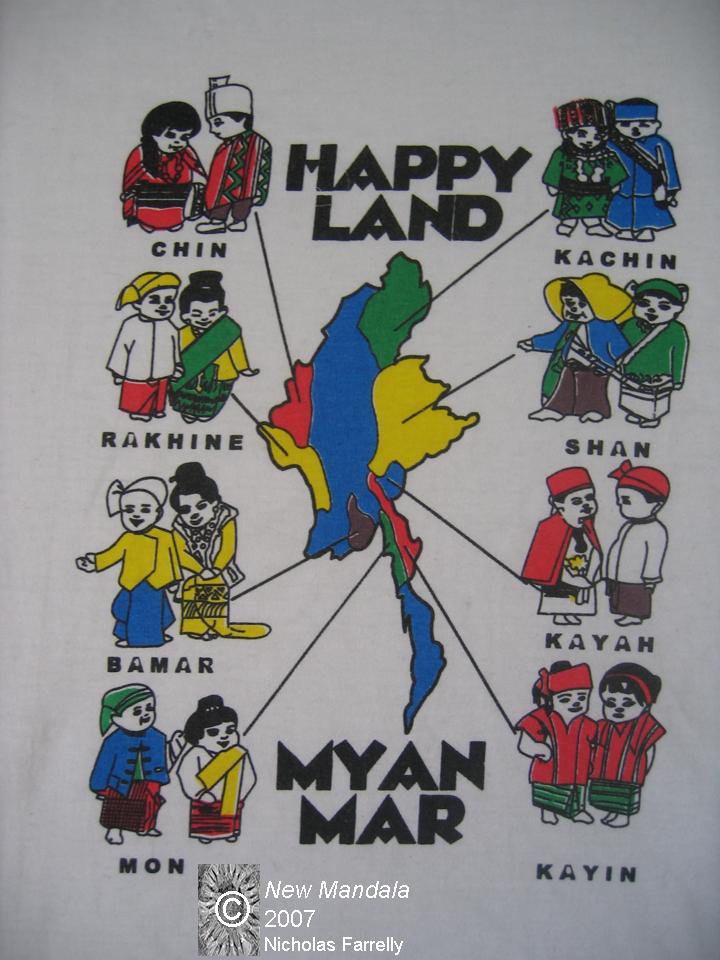Thailand has long branded itself as “amazing“. Singapore has been, well, “uniquely” Singapore for a while now. And Malaysia has spent millions trying to be “truly Asia“. As part of this region-wide mania, Vietnam even ran a contest to come up with its own unique brand. It seems that every country wants to be something special and have a special stamp of national tourism pride.
But what about Burma?
Perhaps any tourist brand will be a hard sell under that country’s current rulers. The military regime, for its part, has made some efforts to motivate interest in “Mystical Myanmar“. But I have never been under the impression that the phrase has exactly caught on.
When I was last there, some retailers in Yangon’s tourist markets had made some new additions to the standard selection of “Golden Land” and “Myanmar – Yangon” t-shirts. Two new slogans particularly caught my eye: “I Love Myanmar” (replete with a love heart and a map of the country) and another that proclaimed “Happy Land: Myanmar”.
These “Happy Land” t-shirts were on sale for a few thousand kyat. Their garish representation of the country’s cultural geography fits the official perspective on Burma’s “harmonious” national territory. Obviously this simple image ignores the ongoing insurgencies in many areas of the country, the difficult ceasefires of other areas, and the military’s ongoing repression of dissent.
Visitors who do get outside the main tourist quarter of Yangon would – one would hope – see the irony in this image.
But that irony still seems to be lost on some.
I was reminded of the “Happy Land” slogan by an article I spotted in the San Jose Mercury News. It chronicles a three-week visit to Burma by Jay Solmonson. He joined a tour to Yangon (of the Shwedagon, he writes: “To our little band of Westerners, it was Wonderland”), Bagan, Inle Lake, and Mandalay.
For New Mandala readers unfamiliar with the military government’s preferred tourist itinerary I should highlight that Solmonson followed their script to perfection. As he says, “I don’t go looking for trouble”. Solmonson’s main article is accompanied by a short justification for this trip to Burma. He writes, “I felt as safe in Myanmar as in any country I have visited. And I have never seen so many people seem so happy with so little”.
Even though his tour group became “disheveled”, they did eventually make it back to Yangon’s “venerable” Strand Hotel. Covered in the dirt of the road, Solmonson writes that “we could put on a happy face. The face of Myanmar”. This persistent image of a smiling, happy country (“We also spent a lot of time smiling on the road to Mandalay”; “zigzagged through the multitude…accompanied by smiles”) oozes from Solmonson’s account.
Of course, reports of a “Happy Land” are precisely what the generals, and their minions in the tourism bureaucracy, hope to hear. They want the world to see Burma uncritically: with its “happy” people and their shared peace and development.
Journalists who unthinkingly corroborate the military government’s line do their readers and the people of Burma a profound disservice.
I certainly agree that it will be a wonderful day when a slogan like “Happy Land: Myanmar” can be proclaimed with a straight face. That day isn’t today.
And that is nothing to smile about.
 Facebook
Facebook  Twitter
Twitter  Soundcloud
Soundcloud  Youtube
Youtube  Rss
Rss 